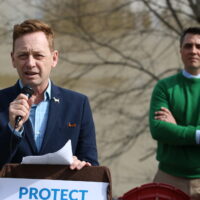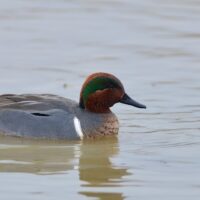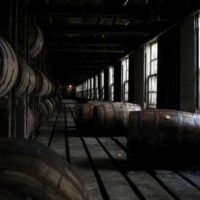Several environmental groups are calling for U.S. Forest Service tornado salvage projects in Land Between the Lakes National Recreation Area to cease.
In a letter sent to the U.S. Department of Agriculture, the Kentucky Resources Council, the Center for Biological Diversity and Tennessee Heartwood outlined why a pair of projects initially aimed at clearing trees downed and damaged during the 2021 tornado outbreak are harmful for the recreation area and the species that inhabit it.
“The Forest Service has created a project area that is almost triple that of the acreage identified as having enough significant damage to justify tree removal,” Kentucky Resources Council director Ashley Wilmes wrote in the letter.
Between the Rivers Inc., Heartwood Inc., Protect Our Woods and the Tennessee chapter of the Sierra Club also called for a stop to the projects in a concurrent letter of support.
Land Between the Lakes was heavily impacted by the natural disaster. Two tornado paths crossed the entire width of LBL, creating a mile-wide path in the northern portion and a quarter-mile-wide path to the south.
In the aftermath of the deadly and historic tornado outbreak — a storm that killed 80 Kentuckians, destroyed or damaged thousands of structures and left a trail of heartbreak across the western and central portions of the Commonwealth — U.S. Forest Service staff identified around 6,500 impacted acres. Of that, the Forest Service identified nearly 2,200 acres as damaged enough for salvage.
However, the groups said the salvage projects expanded far beyond their necessary scope, almost tripling that of the area identified for salvage.
A pair of Forest Service decision memos issued in April 2022 identified the tornado cleanup projects — referred to as the North Tornado Cleanup and South Tornado Cleanup projects — stating their primary purpose was to remove damaged trees with affected stands, including fallen trees and standing damaged trees, for public safety. They also said the cleared forest canopy could allow for natural regeneration and serve as marketable timber.
Davis Mounger is the co-director of the Tennessee Heartwood, a group that works to preserve Tennessee’s public lands. He said emergency provisions were misused to justify a lack of analysis, planning, and implementation standards, as well as transparency and public input.
Mounger also said the Forest Service violated the National Environmental Policy Act (NEPA), which requires federal agencies to assess environmental effects for proposed actions before making decisions, by using what’s called a categorical exclusion. He said these can often limit public oversight and input into projects.
“What they tend to do in a project is they try to state what they’re gonna do for mitigation to avoid damage to forest health streams, soil quality impaction from equipment,” he said. “Well, there is none.”
Many of the trees chopped down during this project, Mounger said, were healthy, mature trees.
“So they’re doing what we call high grading in these areas where it’s less damaged, it’s kind of adjacent to the immediate tornado path, because… that way, they can get big merchantable timber out there,” Mounger said. “It’s pretty easy to see: You’re kind of walking into this still complete forest canopy, and there may be a tree or here or there blown down, and you see stumps where they’ve just cut standing trees, and the stumps you can see – these are the largest trees there.”
The Center for Biological Diversity’s southeast director Will Harlan said the U.S. Forest Service is “illegally logging” at the recreation area and that these projects are part of “a long history of abuse” and “a series of violations and broken promises.”
Harlan referenced a proposal made by LBL to transform more than 8,600 acres of “old, mature, intact forests into a grassland.”
“When that was first proposed, the communities spoke loudly and clearly that they did not want to see this amazing forest turned into a grassland. There’s no scientific support for that at all,” Harlan said. “When I heard that the Forest Service was now planning to use these tornadoes as justification to dramatically expand outside of the tornado zones … by as much as three times more than the initial swath that the tornado cut, cutting down mature forest, cutting down 140 year old trees, that’s what I knew that this had gone way too far.”
Harlan called the biological assessment conducted for the projects “sloppy and inadequate.”
“They did not consider several endangered species, especially aquatic species, some mussels that are in this impacted area and there are several endangered species of mussels and bats that are being harmed by this project,” he said. “Not only was that assessment inadequate of the species, but it left out several species that are being harmed that were not evaluated at all.”
Endangered species in the project area, according to the Center for Biological diversity, include the Northern Long-Eared, Tri-Colored and Little Brown bats, the Pink Mucket and Rabbitsfoot mussels, and the Alligator Snapping Turtle.
A Forest Service public affairs officer indicated Friday that Rhea Whalen, the acting area supervisor over LBL and the letter’s addressee, had not received a letter from the Kentucky Resources Council or the Center for Biological Diversity and was “unable to comment” on it.
A statement from Whalen was included in the emailed response:
“So many people care about this beautiful area we call Land Between the Lakes National Recreation Area. This is part of what makes Land Between the Lakes special. We are thankful for their energy and insight.
“The Forest Service believes all life is interdependent, and that includes the communities of people that depend on Land Between the Lakes. As always, we welcome the thoughts and ideas individuals have about how we manage LBL’s lands and waters.
“Thank you. I look forward to strengthening our partnership with all of these supportive groups.”
After confirming Whalen’s email address, it was discovered that the letter sent Thursday was sent to the wrong email address. The Center for Biological Diversity resent the letter Friday afternoon and confirmed receipt.
Further statements from the U.S. Forest Service are expected in the coming days.






